The Flute has been used to create all genres of music, but recently the Flute has been heard in a genre that has been a surprise, rap music. An example is the singer, songwriter, rapper, and classically trained flutist Lizzo. While not all flutists dance and twerk while playing, there has been more attention on flutists and their abilities to play and move simultaneously to produce fun, exciting, and musical performances.
The Flute is a member of the woodwind family of instruments, including single and double reed instruments. The Flute itself is one of the oldest instruments in the world. The earliest Flutes dated back to the Stone Age and were made of bone or wood. You can find Flutes in a wide variety of bands: jazz, funk, concert, and orchestras, as well as marching bands.
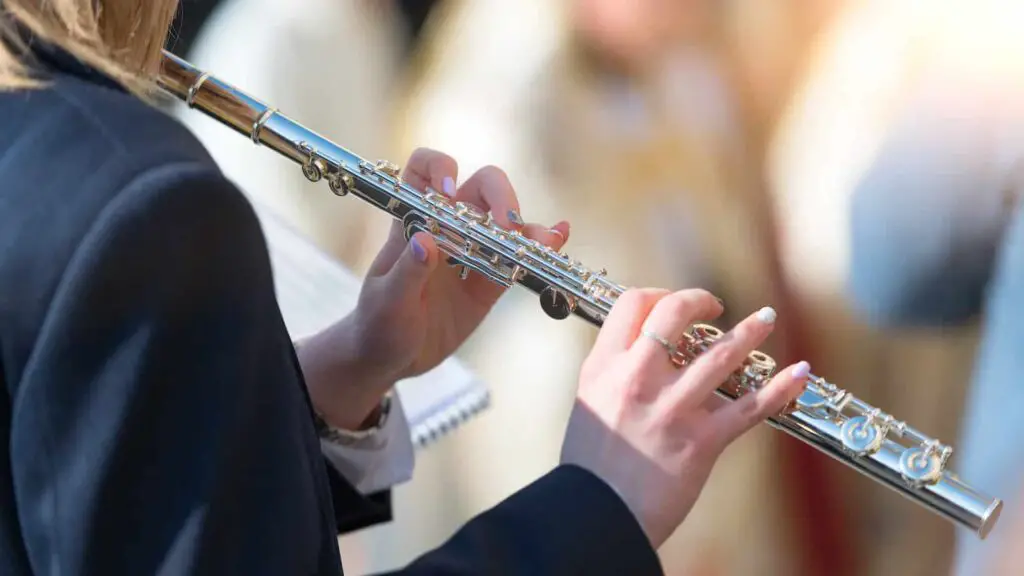
The Flutes we use today are known as “side-blown” or “transverse flutes.” This means the instrument is held horizontally.
Today, flutes for concert bands, jazz bands, marching bands, and orchestras are made of metal and the pitch of the notes is changed when a player closes or opens holes on the instruments. The Flute is a very popular instrument, and it is for both men and women to play.
Are Flutes used in Marching Band?
Yes! Flutes are used in Marching Bands and are one of the instruments that make up the woodwind section of a band.
Smaller-sized Marching Bands may have around 5-8 flute players and 1-2 piccolo players on the field. Larger bands and college Marching Bands can have as many as 40+ flute players in their band. Flutes in Marching Band often play the melodies of the songs and are the masters of the upper registers of music.
What is a Marching Band Flute?
A Marching Band Flute is part of the woodwind section of instruments and is considered an aerophone, which means they produce sound through the vibration of air blown into the instrument.
Unlike all other woodwinds which have reeds, the Marching Band Flute is reedless. Instead of a reed, flautists will blow air across an opening near the top of their instrument.
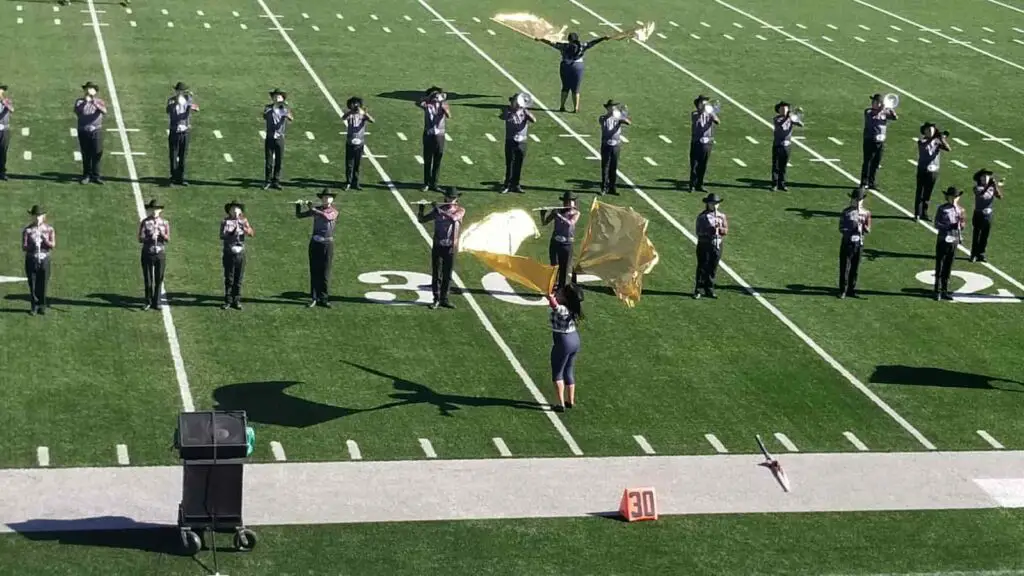
Are there different types of Marching Band Flutes?
Typically, there are two types of Marching Band Flutes you will find on the field, the regular Marching Band Flute, and the Piccolo.
A Piccolo is half the size of a normal Marching Band Flute and is able to play the highest notes in the entire band. It is common to see one to three Piccolo players in smaller marching bands while the rest of the section will play the standard Marching Band Flute.
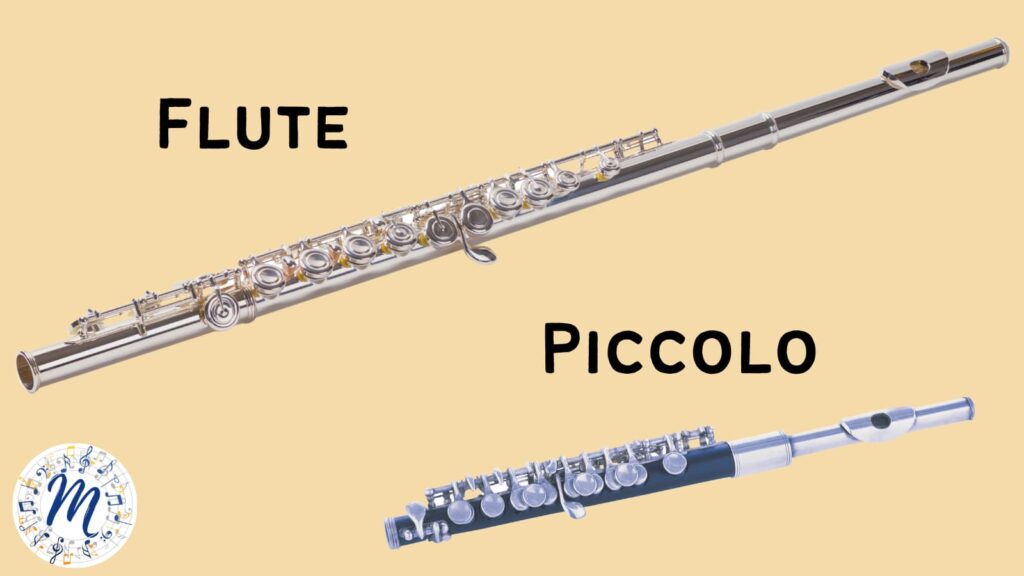
How do you play the Flute in Marching Band?
In the United States, students will have the opportunity to join marching bands when they are in High School (9th-12th grades). By the time a musician reaches high school, they usually have a few years of experience playing their instrument.
If you have already learned to play the Flute, playing the Flute in Marching Band will be an easy transition. If you have never played the Flute but want to join the marching band you can.
Be sure to practice playing the instrument, reading sheet music, and maintaining proper posture you will be a great addition to the Marching Band.
Top Tip: From beginner to advanced musicians, every flutist must maintain proper posture. Your spine should be straight with your head in line. Hunching or leaning back will make proper breathing techniques difficult, and your sound will not be as clear as it should be.
It is important to remember to relax a little bit. If you are too rigid, especially in your hands and elbows, marching and playing will be difficult.
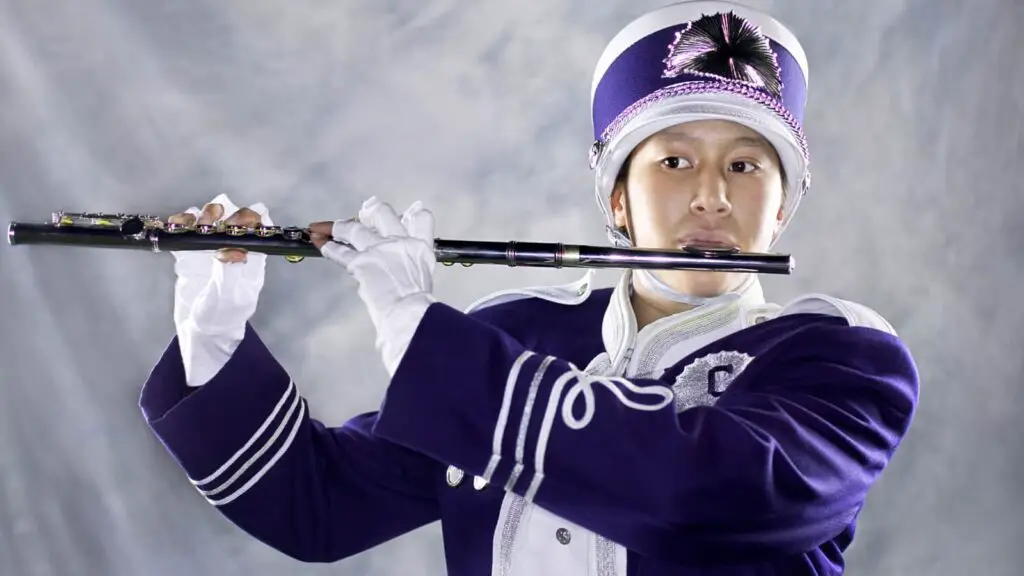
The first step to playing the Marching Band Flute is recognizing its anatomy. The Marching Band Flute has three parts: the head joint, which is held by your mouth, the body, and the foot joint.
On the body and foot of the Flute, you will find the keys which are used to play different notes. At the top of the body, you will find the barrel; it is where you can find the name of the Flute’s maker/brand.
When putting your Marching Band Flute together, the head joint will attach to the body at the barrel.
The head joint features the lip plate over the top of a hole known as the embouchure hole.
The lip plate should rest gently on your chin when holding the Marching Band Flute in a playing position. The final feature of the head joint is the crown; it is the crown that ensures your air travels down and out through the Flute.
The image below shows the anatomy of a Marching Band Flute.
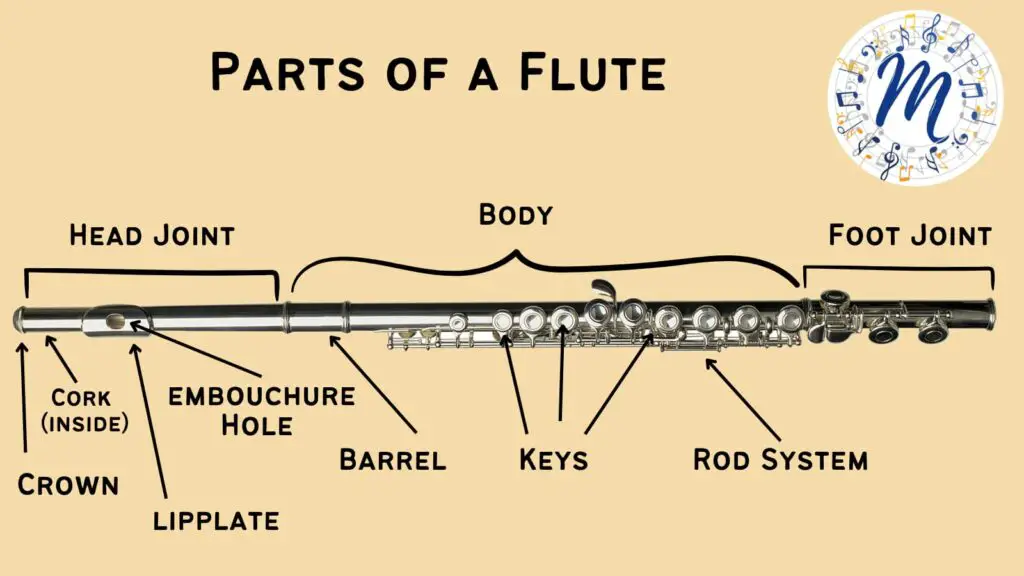
How and Where to Buy a Flute for Marching Band?
Flutes, like all instruments, are expensive and should be considered an investment. There are three options for purchasing a Flute for Marching Band.
Option #1
The easiest way to buy a flute is to go to a local music supply store. Flutes are popular instruments, and they don’t take up a lot of space when storing them in a back room. This means every music supply store will have some Flutes for Marching Band in their store.
Option #2
Next, you can buy the Flute you want online. You can go to the website for the brand of horn you want. You also can order online from a music company. Some reliable music companies that sell Flutes for Marching Band online are
- Woodwind & Brasswind
- Musician’s Friend
- Music & Arts
- Pro Winds
Option #3
You can buy one from an online auction site like eBay or Reverb. Do some research and ensure the instrument you get is correct.
Top Tip: Knowing some brands and model numbers/names will help you find what you are looking for. The instrument’s condition shown in photos on eBay, Craigslist, or Reverb might not be what the Flute they are selling looks like.
There isn’t a difference between a high school or college Flute for Marching Band. It is strongly recommended that a beginner or intermediate (if it is within budget) model of Flute be used for Marching Band.
Flutes, saxophones, and clarinets should not get wet in the rain, but with Marching Band, it happens. A beginner model will cost less to repair if the pads fall off the keys, and it’s okay if it gets minor water damage or you drop it.
Save your nice and very expensive Flute for sit-down band groups like an orchestra or band. You should always care for your instrument, whether it costs $400 or $4,000.
What Brands Are Best?
There are many wonderful brands of Marching Band Flutes that you can buy. A very popular brand for all instruments including the Marching Band Flute is Yamaha.
This company is famous for its expertly crafted and sturdy instruments. I have had my Yamaha flute for 20+ years and although I have had to replace the pads and do minor repairs it still plays wonderfully!
Two other brands that make excellent student Marching Band Flutes are Armstrong and Jupiter.
The chart below compares a few of the best brands and models of Student Marching Band Flutes. Which can be used as a helpful guide when considering purchasing an instrument. The chart compares the body materials, arm styles, plating, key type, and prices.
| Brand | Name/Model Type | Head, Body & Foot Materials* | Arm Style | Plating | Key Type | Price (USD) |
Yamaha | YFL-262Y Standard Flute | Nickel Silver | Pointed A# F# | Nickel Silver | French(Open Hole) | $1,463.00 |
Yamaha | YFL-222 Standard Flute | Nickel Silver | Pointed A# F# | Silver | Plateau (Closed Hole) | $1,097.00 |
Armstrong | AFL 201 Closed-Hole Student Flute | Nickel Silver | Y-Arms | Silver | Plateau (Closed Hole) | $929.00 |
Armstrong | Model 104 USA Student Flute Standard | Silver Plated | Y-Arms | Silver | Plateau (Closed Hole) | $1,279.00 |
Jupiter | JFL710ROA Student Flute | Nickel Silver | Y- Arms | Silver | French(Open Hole) | $1,534.00 |
Jupiter | JFL710A Student Flute | Head and Body: Nickel SilverFoot: Unknown | Y-Arms | Silver | Plateau(Open Hole) | $1,119.00 |
* If there are known allergies to nickel, it is best to speak to someone at a music store or call the customer service lines for the 4 online retailers mentioned in this article to inquire about a safe option. There are nickel-free flutes made of solid silver/gold, but be aware that these flutes will be more expensive than those listed in the chart above.
How Much Does A Flute For Marching Band Cost?
A Marching Band Flute’s price will vary by level. For beginner/student flutes, the average range is $500 – $1,450. The average price for intermediate flutes is $1,500 – $2,500. Advanced and Professional flutes will be the most expensive kind of Flute and can start at around $2,700 or more.
You can see why using a student flute is a good idea for Marching Band.
Instruments are expensive, and many Marching Band Flutes are sold online and on places like eBay. Beware of any instrument that is too low priced. You don’t need to and shouldn’t go broke buying an instrument, but if the instrument you are looking at is less than $500 it may not be the best choice to purchase.
Very cheap Marching Band Flutes are priced low because the quality is not so great.
Some reasons why purchasing the cheapest Flute you can find may not be the best choice include:
🎵 Low metal quality
🎵 Keys that will break or fall off the instrument
🎵 Keys that leak (when there is an improper seal when keys are pushed down and air escapes out of the key and harming your sound.)
🎵 Key pads falling off easily.
Note: In Marching Band, all instruments with pads will experience a loose or missing keypad at some point. It can happen when an instrument is very old or has frayed and loose pads, meaning the instrument should go to a repair shop to fix problematic pads or re-pad the entire instrument.
As discussed earlier, woodwind instruments do not fare well in the rain.
Rain can cause pads to fall off even if the pad was fine when you put your instrument in its case. This is because the instrument wasn’t dried enough before it was returned to its case.
While keypads can and do eventually fall off, they shouldn’t fall off a brand new instrument because cheap glue was used to cut the cost of materials. You pay for quality, not because it was $150 and you found it at Walmart or on Amazon, and it’s cheap.
Another option if you want an instrument but cannot afford to buy (or are unsure if you will like Marching Band) is renting.
How to Rent a Marching Flute
Almost all music instrument shops have the option to rent an instrument.
Renting instruments is a usual practice and is an excellent alternative to buying a Marching Flute if it is out of your budget. When renting, you will pay a fixed price (usually $100 or less) every month that you use the instrument.
Note: It is strongly recommended that you pay a little more for instrument insurance if you rent a Flute for Marching Band.
Instrument insurance means that if the Flute were to get damaged, you would only have to pay a small fee when you repair the instrument. Rental insurance helps cover the major expense of repairs which can save you money, stress, and hassle.
Some schools have a “Rent-to-Buy” program for their band students. In a Rent-to-Buy program, a student will rent an instrument from the school directly and pay a monthly renters fee. By the end of the year or at the end of the Marching Band season, you will have the option to buy the instrument at a decreased price
These programs are not in every school, but for students who have the opportunity to join a Rent-to-Buy program, this can be a huge financial relief.
Do keep in mind that the instruments in these programs are not brand new and can show signs of wear and tear. As long as the instrument plays well and is sturdy, no one will be able to hear the difference between a new flute and a rental when on the football field.

How Much Does a Flute Weigh?
The Flute is the lightest instrument you can carry in Marching Band. An average flute will weigh around 1.13 lbs (18 oz). Still, it can vary by an ounce or two depending on the materials used in the production of the instrument.
That does not mean a musician has it easier than the bass drum or tubas.
The Flute is the only instrument held sideways, which causes you to use muscles in your arms that you may not be used to using for long periods. It is normal for your arms to feel sore or heavy when playing the Flute in Marching Band. Especially during band camps and the first month or so of marching practice!
The weight of an instrument doesn’t indicate the strength of a player. Any boys and young men interested in playing the Flute, remember that the weight of your instrument does not mean you are not a strong person/are feminine for choosing to play the Flute.
How to Hold Music When Playing the Flute
In any other kind of band, the musicians sit in one spot the entire performance and use a music stand to hold their music while they play.
You can’t march, play, and drag a music stand with you in a Marching Band.
Luckily, special devices were built to hold music when in a Marching Band. They are called lyres or flipbooks and are attached to an instrument in a place where a musician can read the notes on the page without looking down the entire show.
The pages in the” book” part of the lyre hold your music and are the perfect size for marching music, which is smaller than the size of traditional sheet music.
When you play the Flute in Marching Band, your lyre will be slightly different than the other instruments in the band.
The lyre will use a strap to attach to your left forearm to hold the music in a readable location.
Note: Getting used to a lyre may feel strange at first and even stranger wearing it over the top of your uniform sleeve. Still, it becomes easier and more comfortable every time you use it.
Below are two photos showing what a lyre looks like and where it is worn on your arm.
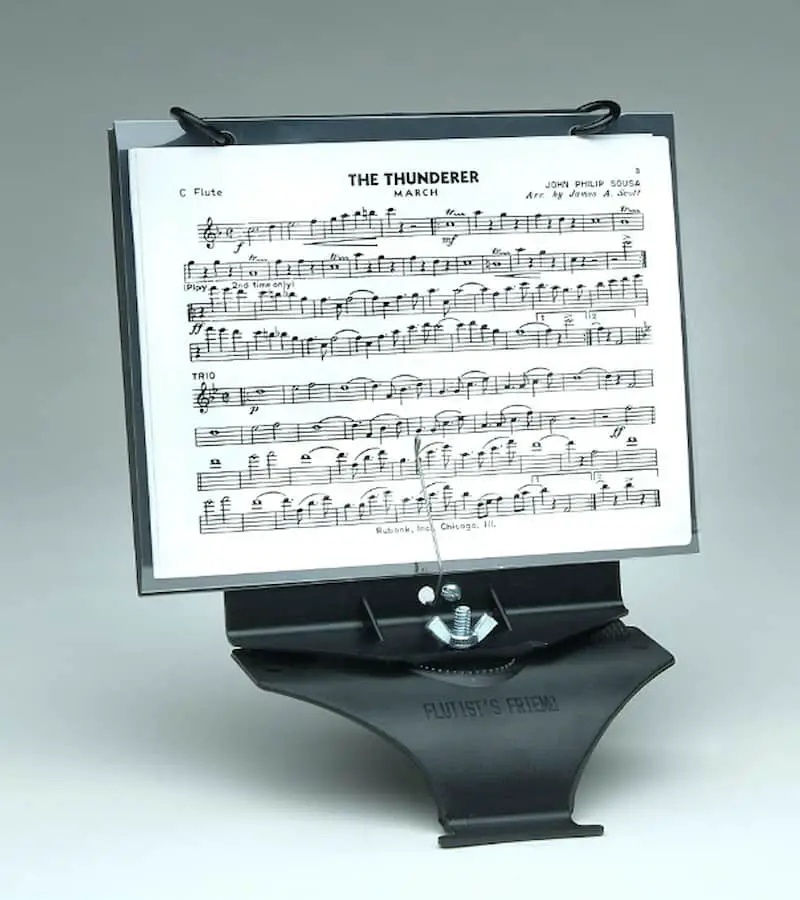
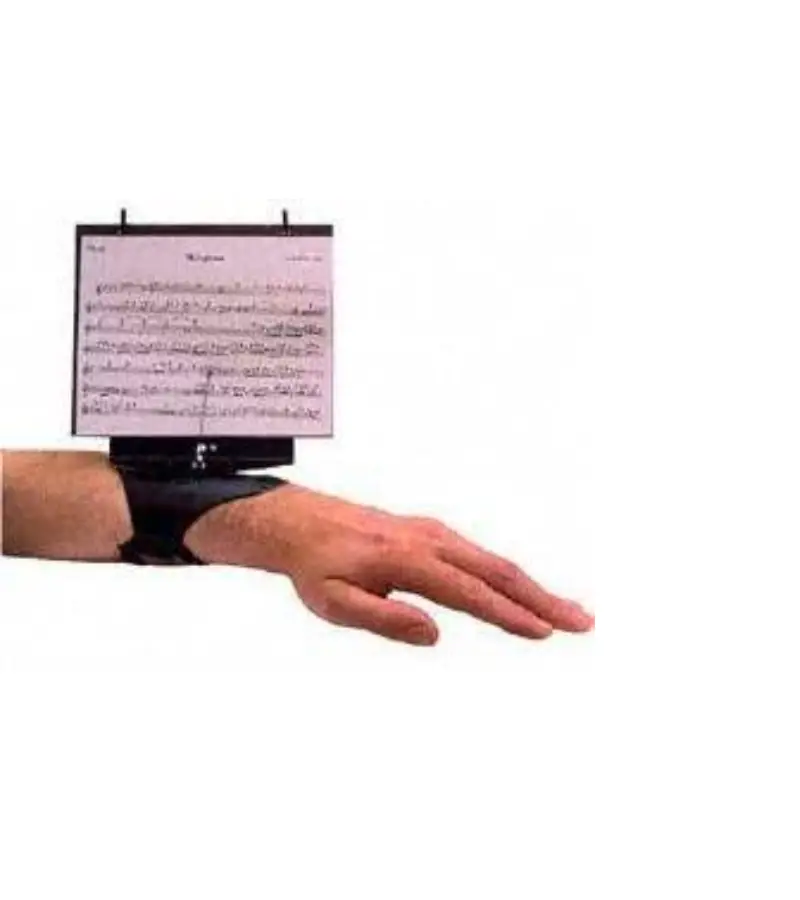
Note: Some band directors may ask the band to memorize their music so they do not have to wear a lyre during halftime or marching competitions.
Unless your band director tells you to memorize your music, you will use a lyre and flipbook to hold your music. Upper-class students may play in the stands without a lyre on, but that is due to them memorizing the same stand music that is used almost every year.
There is nothing wrong with needing your lyre and flipbook in the stands to remember all the new songs you have had to learn in a very short amount of time. It won’t take very long to memorize your stand music because you play it all the time at every game.
In college Marching Bands, you will be expected to use a lyre at practice and during halftime shows. Since a new show is performed for each home game, it is often not enough time to memorize three to four pieces of music, a lyre may be necessary.
Learn more about beginner flute, or Marching band by reading these articles:
Best Shoes for Marching Band (Read This First!)
Instruments in a Marching Band (How Many & What Kind)
Disclaimer: This post may contain affiliate links. We only recommend high-quality products that are used and recommended by real musicians. If you use these links to buy something we earn a small commission.
